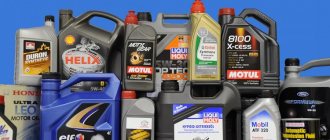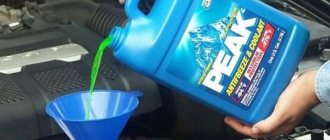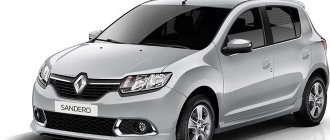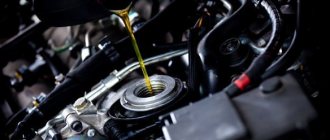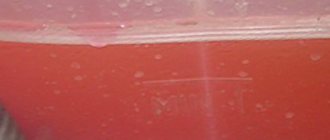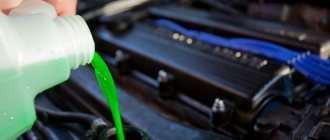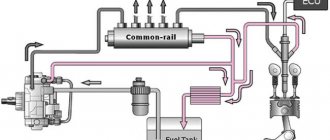1200 rub. for the photo report
We pay for photo reports on car repairs. Earnings from 10,000 rubles/month.
Write:
The presence of air in the cooling system is fraught with problems for both the engine and other components of the car. In particular, overheating may occur or the stove will heat poorly. Therefore, it is useful for any motorist to know how to remove an air lock from the cooling system. This procedure is quite trivial, so even a beginner and inexperienced car enthusiast can do it. Due to its importance, we will talk about three methods of removing air. But first, let's talk about how to understand that air jams are occurring and the reasons for their occurrence.
Symptoms of airiness
How can you tell if there is an air lock in the cooling system? When this phenomenon occurs, several typical symptoms occur. Among them:
- Problems with the thermostat . More specifically, if after starting the engine the cooling fan turns on very quickly, then there is a high probability that the thermostat has failed. Another reason for this may be that air has accumulated in the pump nozzle. If the thermostat valve is closed, the antifreeze circulates in a small circle. Another situation is possible when the coolant temperature needle is at “zero” when the engine has already warmed up enough. Here again, two options are possible - a malfunction of the thermostat, or the presence of an air lock in it.
- Antifreeze leak . It can be checked visually by traces of antifreeze on individual elements of the engine or chassis of the car.
- The pump starts to make noise . When it partially fails, extraneous noise appears.
- Problems with the stove . There are many reasons for this malfunction, but one of them is the formation of an air lock in the cooling system.
If you find at least one of the symptoms described above, then you need to diagnose the cooling system. However, before doing this, it will be useful to understand what caused the possible problems.
Draining old antifreeze
To empty the radiator system, it is not enough to simply turn the tap. As you know, antifreeze is a toxic substance and therefore poses a threat to human health. In this regard, it is important to master important rules for handling it:
- Under no circumstances should you pour antifreeze onto the floor in a garage or on the street, as its toxic fumes can penetrate a person’s lungs and cause severe poisoning.
- Under no circumstances should antifreeze be allowed to come into contact with mucous membranes. If the substance accidentally gets into your eyes or exposed parts of the body, you should immediately rinse these areas under running cold water.
- After completing work related to replacing the coolant, wash your hands thoroughly.
To get rid of old coolant , you need to prepare a large container in advance. It is desirable that it has a wide cavity and a shallow bottom. The fact is that the space under the car is limited, but there is plenty of space in the width. For this reason, car owners most often use a regular aluminum pan for such manipulations.
When all the devices are ready, remove the engine protection, if any. In those salons where there is a stove with mechanical adjustment, the lever is moved to the position corresponding to the maximum temperature. To prevent a vacuum from forming in the system, some people prefer to remove the cap of the expansion tank, but, as practice shows, this often results in liquid splashing.
Next, placing a container under the cooling device, carefully unscrew the radiator drain plug, being careful not to flood the generator and other electrical equipment. But the main thing, of course, is not to damage the heat exchanger honeycombs, because welding them will be very problematic. As soon as all the liquid has been drained, proceed to draining it from the engine.
Move the aluminum trough under the engine and slowly unscrew the drain plug of the cylinder block. Wait for the antifreeze to settle, and after about 15 minutes screw everything back in.
Causes of air locks
Air in the cooling system can be caused by a number of malfunctions. Among them:
- Depressurization of the system . It can occur in a variety of places - on hoses, fittings, pipes, pipes, and so on. Depressurization can be caused by mechanical damage to its individual parts, their natural wear, or a decrease in pressure in the system. If, after you have removed the air lock, air appears in the system again, it means that it is depressurized. Therefore, it is necessary to do diagnostics and visual inspection in order to identify the damaged area.
You need to pour antifreeze in a thin stream.
Each of the reasons described above can damage the components and mechanisms of the car. First of all the engine suffers because its normal cooling is disrupted. It overheats, causing wear to become critical. And this can lead to deformation of its individual parts, failure of sealing elements, and in especially dangerous cases, even to jamming.
Airing also leads to poor stove performance. The reasons for this are similar. Antifreeze does not circulate well and does not tolerate sufficient heat.
Next, let's move directly to the methods by which you can remove the air lock from the cooling system. They differ in the method of execution, as well as complexity.
Procedure for replacing coolant
Antifreeze is replaced in the following sequence:
- The old coolant is drained;
- The cooling system is flushed;
- New antifreeze is added.
All of the above operations must be performed taking into account the nuances that will certainly be described in this article. If you do not follow the recommendations for replacing antifreeze and do not adhere to the rules, then incorrectly replacing antifreeze can lead to disastrous results.
Methods for removing air lock from the cooling system
How to remove an air lock from the cooling system of a VAZ classic
There are three main methods by which you can eliminate an air lock. Let's list them in order. The first method is great for VAZ cars . Its algorithm will be as follows:
- Remove from the engine all protective and other elements that may prevent you from reaching the expansion tank with coolant.
- Disconnect one of the pipes that are responsible for heating the throttle assembly (it doesn’t matter whether it’s direct or reverse).
- Remove the expansion tank cap and cover the neck with a loose cloth.
- Blow inside the tank. This will create a slight excess pressure, which will be enough for excess air to escape through the pipe.
- As soon as antifreeze comes out of the hole for the pipe, immediately put the pipe on it and preferably secure it with a clamp. Otherwise, air will get back into it.
- Close the expansion tank cap and reassemble all previously removed engine protection elements.
The second method is carried out in accordance with the following algorithm:
- Start the engine and let it run for 10.15 minutes, then turn it off.
- Remove the necessary elements in order to get to the expansion tank with coolant.
- Without removing the lid from it, disconnect one of the pipes on the tank. If the system has been aired, then air will begin to escape from it.
- As soon as the antifreeze flows out, immediately replace the pipe and secure it.
Coolant selection
First, you need to figure out how much coolant is provided in the VAZ 2110. This will allow you to purchase the required amount of antifreeze and correctly carry out the replacement procedure.
We have already understood how much coolant is provided in the VAZ 2110, and how much needs to be filled. So it's time to choose.
In order to make a smart purchase of a new antifreeze, follow a few simple rules.
- Purchase a liquid with the same characteristics, color and production that was used previously. Of course, if the previous coolant worked effectively. Mixing different types of antifreeze is a common mistake that can lead to unpredictable consequences.
- Take a closer look at the packaging of the liquid you purchased. Today they sell both ready-to-fill formulations and concentrates, which must be diluted before use.
- Replace antifreeze only when the engine has completely cooled down.
- Start the engine after replacing the coolant strictly after all connections are made and the expansion tank cap is closed.
General recommendations for prevention
The first thing you need to pay attention to is the level of antifreeze in the cooling system . Always monitor it and top up if necessary. Moreover, if you have to add coolant very often, then this is the first call indicating that something is wrong with the system, and additional diagnostics are necessary to identify the cause of the malfunction. Also check for stains from antifreeze leaks. It is better to do this in the inspection hole.
Try to use the antifreeze recommended by your car manufacturer. Make purchases in trusted, licensed stores, minimizing the likelihood of purchasing a counterfeit. The fact is that low-quality coolant can gradually evaporate during repeated heating, and instead of it, an air plug forms in the system. Therefore, do not neglect the manufacturer's requirements.
Instead of a conclusion
Finally, I would like to note that if the described signs of airing in the system appear, it is necessary to carry out diagnostics and check it as quickly as possible. After all, an air lock significantly reduces the efficiency of the cooling system. Because of this, the engine operates under conditions of increased wear, which can lead to premature failure. Therefore, if you detect airing, try to get rid of the plug as quickly as possible. Fortunately, even a novice car enthusiast can do this, since the procedure is simple and does not require the use of additional tools or devices.
The issue of engine overheating due to the appearance of air in the cooling system (air lock) worries many motorists. The topic is quite popular, since not a single car is insured against the appearance of an air lock. First, a few words about where the air in the cooling system comes from, that is, how an airlock is formed. Causes of airlock
The reason for the appearance of air in the system may be leaks in the connections through which air leaks actually occur.
The sooner you find the place of depressurization, the less air will enter the cooling system, therefore, the less damage will be caused to the motor itself. Often, an air lock forms after replacing the coolant (coolant) or partially topping it up. Due to a leak in the water pump or due to damage or wear to the pump gasket or cylinder head gasket. An air lock may form due to a stuck air valve in the expansion tank. How to remove an air lock? Removing air from the cooling system Method No. 1
We drive into a pit and put the car on the handbrake.
Using a jack, raise the car 30-40 cm. Carefully unscrew the cap of the expansion tank, being careful not to get burned. Start the engine and turn the heater to maximum. Slowly start pouring antifreeze into the expansion tank to the maximum. Raise engine speed to 3000 rpm. Next, you need to wait for the thermostat to open and squeeze the lower pipe that leads to the radiator with your hand. When doing this, you need to be extremely careful so as not to get burned, the hose will be hot, so you will need gloves. All the above steps must be done until air comes out of the expansion tank; as soon as you see that liquid is coming out of the tank without air bubbles, check the pipes, they should be hot. Turn on the heater and make sure that hot air flows from the air ducts. Next, you need to lower the front of the machine with a jack and add the required amount of coolant to the level. You should not make the upper level, as this is fraught with overflow, which will sooner or later squeeze out through the lid. Method No. 2
Replacement frequency
The vast majority of vehicle owners keep strict records of when to change the engine oil, completely forgetting that the coolant also requires regular updating. This measure is due to a decrease in the quality of antifreeze as a result of operation. In other words, the properties of antifreeze that is used for a long time deteriorate significantly, and the liquid cannot cope with the thermoregulation functions assigned to it.
The average service life of antifreeze ranges from 50-90 thousand kilometers or from 2 to 5 years. This period may be longer or shorter - it all depends on the coolant manufacturer and the operating conditions of the vehicle. If you do not change the antifreeze in time, quite negative consequences are possible:
- After some time, a sediment will form that will clog the engine cooling channels and the heat exchanger itself. This will negatively affect the operation of the radiator: in the summer the engine will constantly overheat, and in the winter there will be difficulties with warming up.
- Since active components continuously evaporate from the coolant, sooner or later the antifreeze will begin to freeze at low temperatures. Subsequently, a slurry will either form in the radiator, or the engine will “defrost” when the cylinder block is destroyed under the pressure of the formed ice build-up.
It is recommended to replace the used cooling mixture before performing repair work. Used antifreeze is drained if you need to replace the pump, radiator or pipes.
Reasons for airing
The air that has penetrated into the system is collected into one bubble, moving through the channels to a certain place. Having reached the highest point or narrowing, it stops and blocks the flow of antifreeze (antifreeze). Practice shows that most often an air lock occurs in a large circulation circuit, including the main radiator. Although the opposite situation also happens, for example, airing of the heat exchanger of the cabin heater (in common parlance - the stove).
How air enters the cooling system of a car engine:
- the most common case is incorrect filling with antifreeze;
- due to antifreeze leaks through loose connections or faulty parts, for example, a leaky pump seal;
- due to jamming of the bypass valve built into the expansion tank plug.
The main task solved during the process of filling antifreeze is to simultaneously expel air from the cooling system. If you perform the operation in a hurry and do not follow simple rules, the formation of an air lock is guaranteed. Quick filling allows air to enter the system along with the liquid through the funnel, and then collect into one bubble.
Important point! An obvious sign of airing is a critical rise in coolant temperature at any engine operating mode.
The inclusion of an electric fan depends on the make and model of the car: if the temperature sensor is in the cylinder head, forced airflow will definitely work.
If the meter is located differently (in the main radiator, on the pipe), the fan may not start due to the sensor being in a stagnant zone. How will air get through leaks in a pressurized system, you ask? The algorithm is simple:
- During the heating process, the antifreeze increases in volume and displaces the air layer from the expansion tank through the plug valve.
- After the engine stops, the coolant cools and compresses to its previous volume, and the valve lets the air back in.
- As the antifreeze cools and contracts, leaks in the system elements will turn into sources of additional air leaks.
Similarly, airing of the cooling system occurs due to the jamming of the bypass valve. Cooling and shrinking antifreeze provokes the formation of a vacuum, which is not replenished by air flow from the outside. Then suction occurs in the weakest connections.
How to change coolant
Before replacing antifreeze, you need to know that this can only be done on a cooled engine. Antifreeze and antifreeze are aggressive chemicals that can cause harm to the human body, therefore, follow safety precautions and carry out all work with gloves. You can start the car after changing the fluid only after you make sure that the reservoir cap is tightly screwed on.
Drain the coolant
Many drivers are interested in how to drain antifreeze from a VAZ 2110 and do it quickly and correctly.
Before you start changing the antifreeze, you need to place the machine on a horizontal platform. And if this is not possible, then make sure that the back is slightly lower than the front.
- Disconnect the negative terminal from the battery.
- Together with the bracket, remove the ignition module.
Filling with coolant
- Before disconnecting the coolant supply hose, loosen the clamp.
- If the engine is equipped with a carburetor, then you need to disconnect the hose from the fitting so that air can escape during filling.
- We begin to pour antifreeze into the system (about 7-8 liters will be needed) until its volume reaches the level of the upper line of the expansion tank fastening belt.
Air removal methods
If you observe on the dashboard that the operating temperature of the engine is constantly exceeded (100 degrees or more), follow a number of steps to identify the problem:
- examine the joints of the pipes, the water pump and the expansion tank for leaks;
- check the fluid level in the tank;
- make sure that the cabin heater is functioning properly;
- If the temperature sensor is installed outside the cylinder head, check the operation of the electric fan by closing the contacts.
Why is it flowing?
Many drivers complain that coolant sometimes leaks, whether it’s antifreeze or antifreeze. The reasons why the coolant is leaking may be the following:
- loosening of pipe clamps;
- pipes are worn out and need to be replaced;
- there may be air in the system, that is, an air lock;
- insufficient coolant level;
- problems with the radiator;
- the damper is not tightly closed;
- There may also be other malfunctions of the cooling system.
Why is it flowing?
Many drivers complain that coolant sometimes leaks, whether it’s antifreeze or antifreeze. The reasons why the coolant is leaking may be the following:
- loosening of pipe clamps;
- pipes are worn out and need to be replaced;
- there may be air in the system, that is, an air lock;
- insufficient coolant level;
- problems with the radiator;
- the damper is not tightly closed;
- There may also be other malfunctions of the cooling system.
We drain the antifreeze ourselves
To drain antifreeze and fill in new fluid, we need a drain container with a volume of at least 7.5-8 liters.
You will also need keys and flushing fluid if the system needs to be cleaned.
To refill the system, 7–7.5 liters of finished liquid . This must be taken into account if we pour the concentrate and dilute it with distilled water. It is advisable to carry out the work with gloves, since antifreeze is toxic. Before replacement, we will conduct a detailed inspection of the system, eliminate fluid leaks, and replace failed pipes and clamps.
Algorithm
We carry out replacements on a cold engine according to the following algorithm:
- We place the car on a level surface; if possible, we place the car so that its front part is slightly higher than the rear.
- Remove the negative terminal from the battery.
- We install the heater valve in the extreme right, hottest position.
Turn the heater control knob to the right until it stops.
Unscrew the screws securing the engine protection.
Unscrew the plug at the bottom of the radiator.
Using a 13 key, unscrew the plug on the front side of the cylinder block.
Disconnect the fluid supply hose to the throttle body.
Fill with antifreeze to the required level.
Warm up the engine to operating temperature.
Check the coolant level in the expansion tank.
How to choose the right antifreeze
The abundance of brands and specifications of antifreeze often confuses the buyer. Most car owners distinguish antifreezes according to the following characteristics:
- name - antifreeze or antifreeze;
- color - green, red, blue and yellow coolants are available on sale;
- identification marker (G11 and G12).
In modern conditions, antifreeze is completely synonymous with antifreeze. Antifreeze was developed in the USSR in the 70s, therefore it has a domestic name. Antifreeze is the Western name for this auto chemical product; over time, it has taken root in Russia. Both are coolants and have identical functions and properties.
Although the color of antifreeze matters, it is not exactly what car owners understand. There is even a misconception that green antifreeze is of poor quality, but red is the best.
The term “coolant” is in fact the most correct and accurate designation for such compositions
Of course, the recommendations not to mix antifreeze of different colors should be followed, but you cannot rely only on color. The color is given to antifreeze using dyes at the factory; it is intended primarily for the manufacturers themselves, so as not to confuse product batches.
The manufacturer may well paint the coolant a certain color, although its chemical composition may not be compatible with antifreeze of a similar color from another factory.
Another marker gradation (G11 and G12) is also not entirely logical. It is intended exclusively for cars of the VAG concern (Volkswagen, Skoda, Audi, etc.), which developed it. Therefore, it is not entirely correct to apply such a classification in relation to other car brands. For example, G11 antifreeze was intended only for VAG cars up to the year 96; subsequent models required G12 coolant. Antifreezes with the G11 index are still offered on the auto chemical market. But if G11 from VAG contained silicates, then modern products with such a marker often contain borates and even phosphates, which contradicts the very principles of this classification.
The conclusion from this difficult situation is very simple. You should not select antifreeze solely by color, index or name. You just need to look at the car manual and find the brands and names of coolant recommended by the manufacturer. Each factory specifies acceptable technical fluids, including antifreeze, so you should only rely on the car’s owner’s manual. Just fill in the coolant recommended by the car manufacturer, and you don’t have to worry about your choice.
